Just look at the messages that were waiting for me in my Messaging Tray.
GNOME 3 is awesome! We are already thinking ahead too.
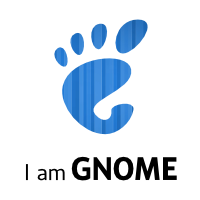
Just look at the messages that were waiting for me in my Messaging Tray.
GNOME 3 is awesome! We are already thinking ahead too.

The eight GNOME Outreach Program for Women interns have just completed their internships! Congratulations to everyone on the job well done! We definitely hope this was a great experience for you and you will stay involved in GNOME!
The GNOME Foundation will be sponsoring three more internships for women from May 23 to August 22, 2011. These dates match the ones for the Google Summer of Code program, so that we can also encourage women who qualify for Google Summer of Code to apply for both programs. Google Summer of Code requires applicants to be students applying for coding projects, while Outreach Program for Women internships are open to non-students and non-coders. For example, three out of eight interns last round were non-students, and two others worked on the Documentation Project.
The application deadline is April 8, 2011. As part of the application process, we are asking women to take the time to learn about the participating projects and make a small contribution to the one they are interested in. These projects include ones in programming, graphic design, documentation, and marketing.
This deadline is a little over three weeks away, so immediate help with spreading the word about the program is hugely appreciated. You can e-mail the program information to the relevant departments at your university or to a technical women group, post the flyer at your university or hand it out at a conference you are attending. Perhaps, you even personally know somebody who should apply! The linked page has the text for the e-mail you can send to people, the flyer you can attach to an e-mail or print out, and even a sample dent / tweet :)!
As always, people are welcome to add their projects to the list of participating projects and add themselves as mentors. Companies are encouraged to sponsor additional internships on the projects of their choice.
Thanks to Máirín Duffy for updating the flyer during a stop-over en route to SXSW!
The message tray in GNOME Shell enables persistent notifications. A new notification is first shown as a pop-out for a certain time period. When the pop-out is hidden, the notification is still available to the user in the message tray. The notification is only removed when the user interacts with it or switches to the application that sent it. This default persistent behavior ensures that the notifications are less disruptive to the user because the user is no longer forced to react to them before they time out.
Before the holidays, I finished implementing support for two other types of notification behavior: resident and transient. Resident notifications are available to the user even after the user has interacted with them or with the application that sent them. On the other hand, transient notifications are not kept around for the user at all after they are initially shown.
Jon McCann has updated the Desktop Notification Specification to expose these new features to applications. The “persistence” capability advertised by the notification server means that the notifications are persistent by default and that resident and transient notifications are supported. “resident” and “transient” hints on the notifications are used to mean that the notification should be resident or transient.
Resident notifications often go along with rich controls in notifications. Rhythmbox notifications are a good example. During his GSoC, Matt Novenstern came up with a way of specifying icons to be used as notification’s actions, enabled this feature in GNOME Shell, and wrote a patch for using icons for the playback buttons in Rhythmbox notifications. Jon has updated the Desktop Notification Specification to reflect this feature. When the notification server has the “action-icons” capability and the notification has the “action-icons” hint set, named icons that match the action identifiers are used for the notification’s action buttons.
Putting it all together, Jonathan Matthew has reviewed and pushed Matt’s patch for playback icons and made Rhythmbox notifications resident. Resident behavior of Rhythmbox notifications allows the user to see what’s playing and use the playback controls at any time. Incidentally, Jonathan has also worked on the GNOME Shell side of things, coming up with the initial patch for the resident notifications support.
Empathy chat notifications are also resident in GNOME Shell. Because they allow chatting inline in the text entry field they contain, making them resident enables the user to continue a conversation at any time.
The resident behavior and rich features of Rhythmbox and Empathy notifications help minimize the distraction from intermittent events. They allow the user to react to such events at the user’s own convenience and without switching away from the window the user is working in.
Applications should use resident notifications if they are so heavily notification based that the user would expect to see a notification in the tray most of the time and use the application by interacting with its notification’s rich features. In this case, the user should be able to reliably find the notification and not have to guess if there is one in the tray or not.
The other new type of notifications, transient notifications which don’t stay around in the message tray, are mainly intended for use by the system components that have a permanent representation elsewhere, such as in the system status area in the top panel. For example, non-critical battery information notifications are transient.
Transient notifications can also be used as a feedback for the user’s action within the system. For example, they are used when the user adds or removes a favorite application in the Activities Overview mode and allow undoing the action.
Persistent and resident notifications enable complete interaction between the user and the application using only notifications. In GNOME 2, authors would use GtkStatusIcon to anchor the information shown in the notifications, but this is no longer necessary and the applications should move away from the GtkStatusIcon usage. The suggestions for individual applications and system components can be found in these compatibility guidelines. Please find us on #gnome-shell IRC if you would like to discuss the use of the notifications by your application in GNOME 3 or help out with the message tray features.
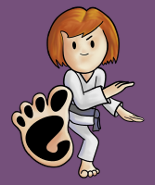 Today, the GNOME project announced eight participants of the Outreach Program for Women internships! The internships will take place between December 15, 2010 and March 15, 2011. In the next few weeks, we’ll add the participants’ blogs to Planet GNOME, so that they can introduce themselves as well as write weekly updates about their work. Say “hi” to them on their blogs or when you see them on IRC. Also, if you are at the Boston Summit this weekend, say “hi” to Tiffany and Eugenia who will be attending it too.
Today, the GNOME project announced eight participants of the Outreach Program for Women internships! The internships will take place between December 15, 2010 and March 15, 2011. In the next few weeks, we’ll add the participants’ blogs to Planet GNOME, so that they can introduce themselves as well as write weekly updates about their work. Say “hi” to them on their blogs or when you see them on IRC. Also, if you are at the Boston Summit this weekend, say “hi” to Tiffany and Eugenia who will be attending it too.
One of our requirements for applicants was to make a contribution to the project they are interested in. All of our selected participants succeeded in making a good non-trivial contribution, so we know they are ready to dive into their work! They all share great enthusiasm for their projects, GNOME, and free software. Please meet:
Tiffany Antopolski (mimico) has completed her third year of Software Engineering at McMaster University in Hamilton, Ontario, which is near Toronto, in Canada. She is taking this year to do a co-op position, in which she is teaching sessions and labs in a first year programming course. Tiffany has also helped design the curriculum for the course. She will work on the Documentation Project with Paul Cutler as her mentor.
Nanci de Brito Bonfim (nanci) is a graduate student in Computer Science at the Federal University of Bahia in Salvador, Brazil. As one of her previous involvements with free software, Nanci has been filing bugs and working on quality assurance tests for BrOffice.org, a Brazilian Portuguese version of OpenOffice.org. Nanci has used Anjuta before for programming in C. She will work on Anjuta with Sébastien Granjoux as her mentor.
Luciana Fujii Pontello (fujii) has graduated with a Bachelor’s Degree in Computer Science from the Federal University of Minas Gerais in Belo Horizonte, Brazil in 2006. Luciana is one of the main developers of Landell, a free software multimedia streaming tool developed using Python, GTK+, and GStreamer. She has also developed the cairoimageoverlay plugin for GStreamer for overlaying an image over a video. She has first peeked into the Cheese code earlier this year when learning how to write a GStreamer application. Luciana is leaving her current job as a developer working on Landell at Holoscopio, a small free software consulting and development company, because of her interest to work directly with GNOME. She will work on improving libcheese and GNOME Video Effects with Thiago Sousa Santos as her mentor.
Eugenia Gabrielova (genia) has recently graduated with a Bachelor’s Degree in Computer Science from Northwestern University in Evanston, Illinois, which is near Chicago, in USA. She currently works as a Research Software Developer at the Northwestern University Medical Simulation Lab, creating a video game about emergency medicine for medical students. She is a sole developer on this project and is developing it on an Ubuntu system using Python. Eugenia has used Anjuta before for her school assignments. Eugenia will work on Anjuta with Johannes Schmid as her mentor.
Laura Elisa Lucas Alday (stringlau) is a fourth year Computer Science student at the John F. Kennedy Argentine University in Buenos Aires, Argentina. Laura has five years of full-time professional software engineering experience using Visual C/C++ for applications related to video management and computer security. She has used many free software applications and libraries while working in the Windows environment and has been using Ubuntu at home. She is currently staying at home with her five months old son Rafael. Laura will work on Cheese with Daniel Siegel as her mentor.
Hellyna Ng (hellyna) is a third and final year student in the Digital Systems Security program at the University of Wollongong. She is taking her courses through the Singapore Institute of Management Global Education program. She lives in Johor, Malaysia and commutes to Singapore for school. Hellyna has used Arch Linux, (K)(X)Ubuntu, Fedora, Gentoo, Linux Mint, and Sabayon Linux distributions. She has previously compiled the kernel and built from scratch Arch Linux and Gentoo distributions. She’ll be taking a term off at school to participate in the program. She will work on GNOME Shell with me as her mentor.
Natalia Andrea Ruz Leiva (nruz) is a fourth year Computer Science student at the Federico Santa María Technical University in Valparaíso, Chile. Natalia participates in the development of the Guitar Boost free software video game for learning to play electric guitar by connecting it to the computer and following the tablature on the screen that shows how the song is played. Natalia will work on the Documentation Project with Paul Cutler as her mentor.
Chandni Verma (glassrose) has recently graduated with a Bachelor’s Degree in Computer Science from Dr. M.C. Saxena College of Engineering & Technology in Lucknow, India. She is particularly interested in data structures, algorithms and cryptography, and has worked on school projects involving them, such as an online national polling system. Chandni also maintains a library with her implementations of over a 100 different algorithms and participates in various online programming contests. Chandni learned about this internship program when already working on her first contribution to Empathy. She will work on Empathy with Danielle Madeley as her mentor.
There are many people and organizations I’d like to thank for making this program happen! Thank you to the GNOME Board of Directors for expressing a desire to run this program and for providing funding for three participants! Thank you to Google for funding four more participants and to Collabora for funding one more participant! Special thank you to Stormy Peters for providing me with irreplaceable feedback day in and day out! Thank you to Paul Cutler, Danielle Madeley, Johannes Schmid, and Daniel Siegel, who in addition to signing up as mentors from day one helped a lot with planning the program and working with the applicants! Thank you to Sébastien Granjoux and Thiago Sousa Santos who stepped in as mentors on a last minute request and saved the day! Thank you to Chris Ball and Hanna Wallach for running a trailblazing Women’s Summer Outreach Program in 2006, showing that it generates a lot of interest, and providing us with great input for this program! Thank you to Máirín Duffy for designing an awesome logo and flyer! Thank you to Emily Chen, Diego Escalante Urrelo, Amber Graner, Rikki Kite, Pockey Lam, Germán Póo-Caamaño, Izabel Valverde, Marco Villegas and everyone else who helped spread the word! Thank you to Joe ‘Zonker’ Brockmeier for working on the press release with me and Stormy! Thank you to Rosanna Yuen for helping figure out how the payments for the program will work! Thank you to Jonathan Blandford, Jon McCann, and Owen Taylor at Red Hat for being very supportive of my work on this!
Finally, thank you to our participants for showing up and being so enthusiastic about this program! Congratulations and rock on! 🙂 Thank you to everyone else who applied and worked on project contributions! Please stay involved in GNOME and apply next time if we couldn’t accept you this time around.
As part of the Outreach Program for Women in GNOME, the GNOME Foundation is sponsoring at least three internships for women from December 15, 2010 to March 15, 2011. These internship dates are aimed at the college women in the Southern Hemisphere who will have a school summer break during this time. However, any woman who has relevant experience and is available for a full-time internship is welcome to apply.
The application deadline is October 25, 2010. As part of the application process, we are asking women to take the time to learn about the participating projects and make a contribution to the one they are interested in. These projects include ones in programming, graphic design, documentation, and marketing.
Here is the program flyer designed by Máirín Duffy!
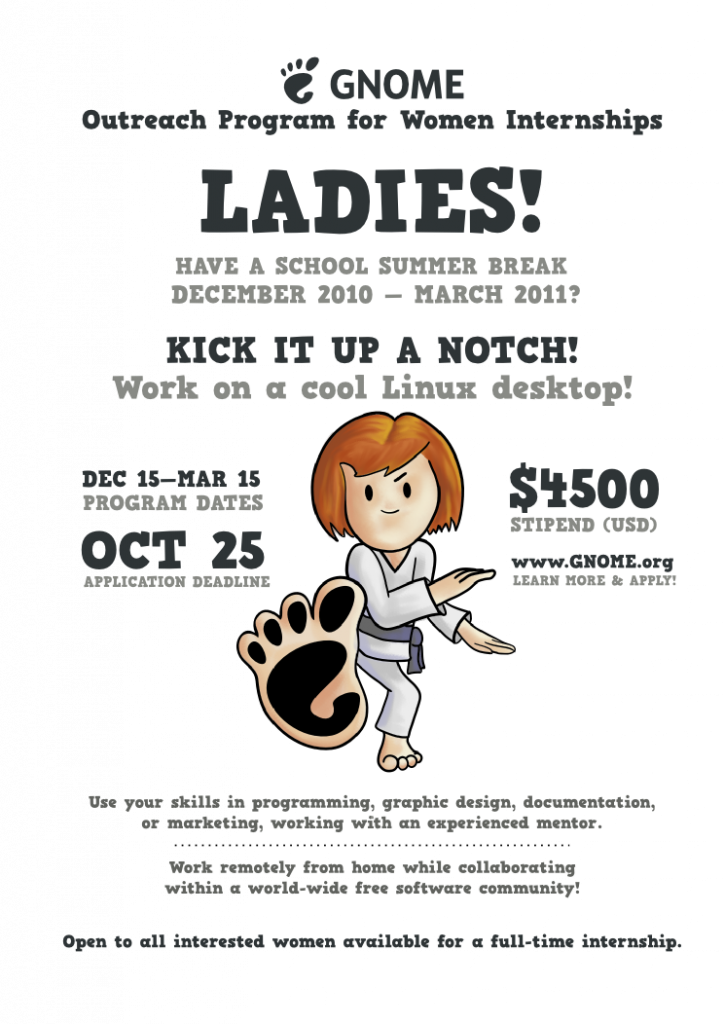
I’d like to ask people in the GNOME community to help with the women outreach effort in these two ways:
Be a mentor – Add your project to the list of projects participating in the program. This list is not only intended as a list of possible internship projects, but also as a list of friendly contacts who women who find out about GNOME can ask for help anytime throughout the year. Even though it goes without saying that all GNOME projects welcome new contributors, just having the text that speaks directly to women will give them the extra encouragement to get involved!
Spread the word – Especially if you live in the Southern Hemisphere, you know best which universities and organizations we should send the information to. You can post the program flyer at your university or hand it out at a conference you are attending. Perhaps, you even personally know somebody who should apply! The linked page has the text for the e-mail you can send to people, the flyer you can attach to an e-mail or print out, and even a sample dent / tweet :)!
Thank you for your help!
The GNOME community would like to ensure a consistent, on-going effort to engage more women with the project and is therefore organizing a new Outreach Program for Women. The goal of the program is to encourage women’s participation throughout the year and create internship opportunities in the summer. This program is a part of a larger free software community effort to increase women’s participation.
The reason we need to have information and opportunities targeted specifically towards women is that this will get more of them involved. It will allow more of them to learn how exciting, varied and valuable work on GNOME can be and how inclusive the community really is.
We already have a good list of mentors for the program and would love to have more sign up, so please add your name to the list if you are interested. A couple women have already come across the information about the program and gotten in touch with the mentors. Their involvement with the projects and guidance from the mentors can start now, which means that the program is basically providing them with the information on how to get started contributing to GNOME and a friendly contact for the questions they will likely have. We are encouraging students and mentors to work together before the application period, so that the students are well familiar with the projects before they apply for the internships and the mentors have the contributions they can take into account during the selection process.
Having summer internships with GNOME will create an opportunity for women to dedicate more time to their work on free software and make a greater contribution to the project. We would like to have these opportunities available in addition to the Google Summer of Code because this will allow us to have a more focused program and will ensure that more women learn about and participate in it. Moreover, we would like the new program to include non-programming projects such as graphics design, interaction design, documentation, and marketing. We are also considering organizing the program so that participants can work as part of the team starting with smaller contributions and progressing to larger ones, rather than working on stand-alone projects. This is more similar to the way companies run their internship programs and will ensure that contributions get incorporated into GNOME throughout the summer.
The GNOME Foundation would like to be able to provide stipends to several students similar to the ones offered in the Google Summer of Code and we need to raise funds for this purpose. I’d like to ask you to consider contributing towards this program or to make a comment that you’d like your contribution to be used towards this program when contributing through Friends of GNOME. We are also seeking corporate sponsorship for the program, so please let us know if your company would like to participate.
GNOME Outreach Program for Women will allow more women to learn how exciting and approachable the free software is and to gain the necessary qualifications to work in the free software industry, contribute to and create free software projects. I am personally very excited about having this program in GNOME because the knowledge and experiences that I have gained by working in the free software community have greatly enriched my life and I believe it is important that more women have such similar opportunities.
There has recently been a surge of activity to promote participation of women in open source that includes a series of interviews with women in open source in the ROSE Blog, plans to host a women in free software mini-summit, and the FSF and GNOME considering running another women outreach program.
Here are some questions that I was recently asked by friends or asked myself as I was contemplating the subject. Please share any additional questions or answers that you can think of.
What are the benefits of open source?
What are the benefits to women of getting involved in open source?
What are the benefits to the open source of getting more women involved?
What are the activities that people take up in the open source community?
Why are women staying out?
What are the things that can be done to get more women involved in open source?
I am at the Gran Canaria Desktop Summit thanks to the generous sponsorship from the GNOME Foundation! It’s great to be meeting old and new friends here.
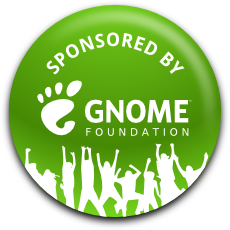 |
I’ve been working on implementing the new design for the Overview mode for the GNOME Shell based on these mockups by Jeremy in the weeks leading up to the conference. The Overview mode is intended to give the user a quick way to switch activities, organize windows among workspaces, and find and launch new applications and documents. Essentially, this mode is a zoomed out view of all workspaces plus menus for starting new tasks. Some advantages of having such mode are:
The recent changes to the view include:
These changes make using the Overview mode feel more stable and predictable because different areas no longer shift around.
Here are the two screenshots of the Overview mode. The user can get to this mode from the main desktop view by clicking the Activities button in the top left corner, pressing the System key or Alt+F1. The first screenshot shows off a single workspace with open windows, favorite applications, non-favorite running applications, and recent documents. The second screenshot shows off search results along with a details preview for one of the results.

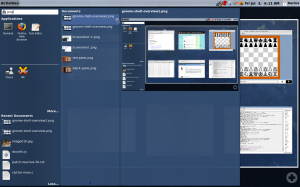
There are still a lot of enhancements based on the mockups that need to be done in this view, such as indicating which applications are running with a glow around the icon, showing more details for an item, including “Places and Devices” section in the left side pane, and adding more polish in general. However, I feel this is a good start that shows off the intended behavior.
We look forward to getting more people involved with the design and development of the GNOME Shell, so be sure to check out Owen’s Introduction to the GNOME Shell talk on Sunday and the GNOME Shell Design BoF Jon and I are hosting on Thursday. Of course you are welcome to come discuss stuff with us any time during the conference and try the GNOME Shell for yourself.